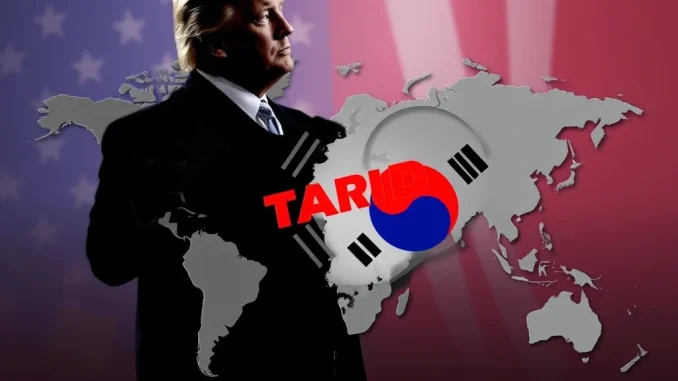
Get ready for a potential shake-up in global trade! Former U.S. President Donald Trump has once again made headlines, this time with a bold announcement from the Rose Garden. In a speech focusing on reciprocal tariffs, Trump declared a significant tariff of 25% on Korean imports. This move has sent ripples through international trade circles and sparked immediate discussions about its potential impact on the global economy. Let’s dive into what this means and why it’s causing such a stir.
Why the Sudden 25% Tariff on Korean Imports?
According to a post by Walter Bloomberg on X (formerly Twitter), Trump justified this 25% tariff by pointing to existing tariffs imposed by other major economies. He highlighted that China’s tariffs stand at 34%, Japan’s at 24%, and the European Union (EU) faces a 20% tariff. Trump’s argument centers around the concept of ‘reciprocity’ – the idea that trade relationships should be balanced and fair. Essentially, he’s suggesting that if other nations impose high tariffs on U.S. goods, the U.S. should respond in kind.
But what does this mean for Korean imports specifically? Korea is a major trading partner with the United States, and a 25% tariff could significantly impact various sectors. From electronics and automobiles to consumer goods, Korean products entering the U.S. market will now become considerably more expensive. This price hike could affect consumer choices, business strategies, and overall trade dynamics between the two nations.
Comparing Tariffs: How Does This Stack Up?
To put this 25% tariff into perspective, let’s look at the comparative figures Trump cited:
- China: 34% Tariffs – China, a global economic powerhouse, has historically had higher tariff barriers in certain sectors. Trade relations between the U.S. and China have been complex, often marked by trade disputes and negotiations.
- Japan: 24% Tariffs – Japan, another major Asian economy, also maintains a system of tariffs. While slightly lower than China’s, Japan’s tariffs still represent a significant barrier to trade in certain industries.
- European Union (EU): 20% Tariffs – The EU, a massive economic bloc, applies tariffs across various sectors. Trade discussions between the U.S. and the EU have been ongoing, aiming to streamline trade and reduce barriers.
- South Korea: New 25% Tariff – With this new 25% tariff, the U.S. is now placing Korea in a similar tariff bracket as major economic players like China and Japan, at least in terms of stated percentages.
It’s important to note that these are broad figures and specific tariffs can vary significantly depending on the product category and trade agreements. However, Trump’s comparison serves to illustrate his rationale – that the U.S. is simply responding to existing global tariff levels.
Is This the Start of a New Trade War?
The announcement of a 25% tariff on Korean imports naturally raises concerns about escalating trade war tensions. When one country imposes tariffs, it often leads to retaliatory measures from the affected nation. Could South Korea respond with tariffs on U.S. goods? This tit-for-tat scenario is the very definition of a trade war, and it can have damaging consequences for all parties involved.
Potential Impacts of a Trade War:
- Increased Costs for Consumers: Tariffs are ultimately paid by consumers through higher prices for imported goods. A 25% tariff on Korean products will likely translate to increased prices for American consumers.
- Damage to Businesses: Businesses that rely on imported Korean components or materials will face higher costs, potentially impacting their profitability and competitiveness. Korean exporters will also suffer from reduced demand in the U.S. market.
- Economic Uncertainty: Trade wars create uncertainty in the global economy. Businesses may delay investments, and markets can become volatile as trade relationships become strained.
- Geopolitical Tensions: Trade disputes can spill over into other areas of international relations, potentially affecting diplomatic ties and geopolitical stability.
While it remains to be seen how South Korea will respond, the risk of escalating trade tensions is certainly real. The global economic community will be watching closely to see if this move is an isolated incident or the beginning of a broader shift in U.S. trade policy.
Actionable Insights: What Does This Mean for You?
For those involved in cryptocurrency and financial markets, developments like these tariffs are crucial to monitor. Here’s why:
- Market Volatility: Trade wars can trigger volatility in financial markets, including cryptocurrency markets. Uncertainty and fear can drive investors towards or away from different asset classes.
- Economic Indicators: Keep an eye on economic indicators related to trade, inflation, and economic growth in both the U.S. and South Korea. These data points can offer clues about the real-world impact of these tariffs.
- Geopolitical Risk: Increased geopolitical risk, stemming from trade tensions, can influence investment decisions. Some investors may seek safe-haven assets during times of uncertainty.
- Supply Chain Disruptions: Tariffs can disrupt global supply chains. This could have knock-on effects across various industries, potentially impacting companies involved in blockchain technology or cryptocurrency mining hardware.
Conclusion: Navigating the New Tariff Landscape
Donald Trump’s announcement of a 25% tariff on Korean imports is a significant development in the ongoing story of global trade. While the stated aim is to achieve reciprocal trade relationships, the move carries the risk of escalating trade tensions and creating economic uncertainty. For those in the cryptocurrency and broader financial world, understanding these shifts in trade policy is essential for navigating the evolving economic landscape. Keep informed, stay vigilant, and be prepared for potential market fluctuations as the world responds to these new tariffs.



